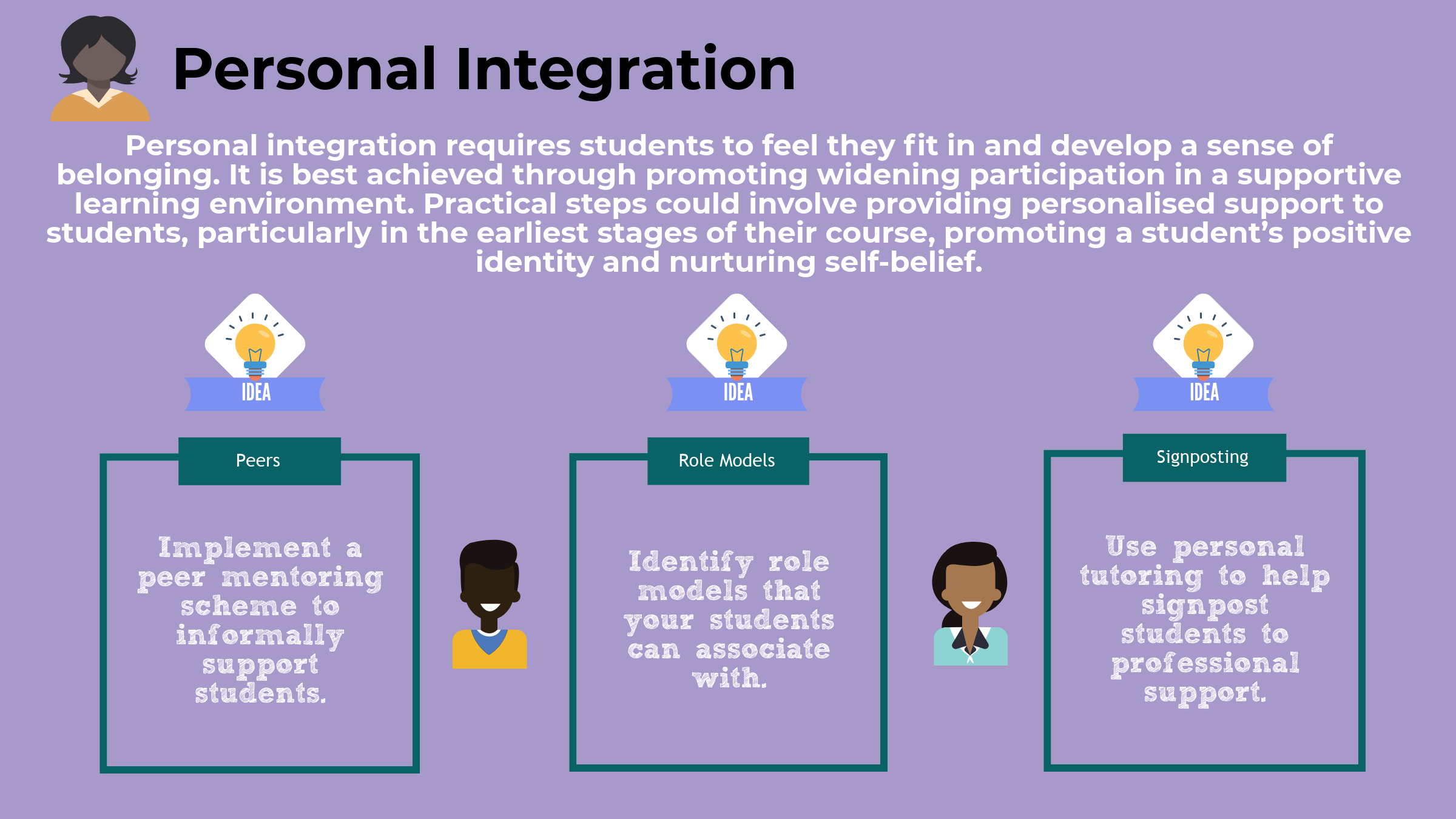Leeds Beckett University - City Campus,
Woodhouse Lane,
LS1 3HE
personal integration
It is the responsibility of the School and the course team to ensure that all new students, regardless of background, culture, disability, or other characteristics are able to fully integrate into the University and into their course.
Personal integration of all first-year students is best achieved through proactively and positively promoting widening participation in an inclusive learning environment.
Students need to feel they belong. On entering higher education many students, particularly those from underrepresented groups, can encounter alien language and procedures, feelings of isolation and lack of sense of positive identity. This can impact negatively on graduate outcomes and student continuation.
The curriculum can play an important role in supporting personal integration. An inclusive curriculum that relates to a student’s personal context and an environment that celebrates diversity underpin personal integration. The NUS’s ‘Why is My Curriculum White?’ campaign (2015) suggests proactive choice of case studies and books and use of personal experiences to describe content can support developing the voice of BME students within a course. Some forms of assessment may privilege some students so increasing assessment choices can support all students to perform better, feel happier and thus integrate better into their course. Care with the language about course work and course information, co-development of activities and co-development of assessment can all act to develop a sense of belonging. Find out more about inclusive assessment practice.
Self-efficacy and a sense of belonging can be effectively nurtured through providing role-models. Peer mentoring schemes and buddying that provide opportunities for new students to be supported by established students who have faced and overcome similar challenges, can effectively underpin personal integration of new students whilst, at the same time, providing students opportunities to deepen social integration.

Lisa Gorton - Active participation from the course team
Tom Muskett - Engaging students through dialogue
Nehal Mahtab - Creating a sense of belonging with SEMS
Tom Muskett - Facilitating dialogue in large group teaching
Simon Warren - Joint projects for UG / PG students
Julia Claxton & Helen Rodgers - Innovative assessment - boardroom role play
- Anagnostopoulou, K. & Parmar D. Eds. (2010) Supporting the First Year Student Experience Through the use of Learning Technologies. Higher Education Academy
https://www.heacademy.ac.uk/system/files/elfyse_anagnostopoulou_parmar_2010.pdf - Chang, M. J., Denson, N., Saenz, V., & Misa, K. (2006). The Educational benefits of Sustaining Cross-Racial Interaction Among Undergraduates. Journal of Higher Education. 77(3), 430-455. doi: http://dx.doi.org/10.1353/jhe.2006.0018
- Chickering, A. W., & Gamson, Z. F. (1987). Seven Principles for Good Practice in Undergraduate Education. AAHE Bulletin. 39(7), 3-7.
- Chickering, A. W., & Reisser, L. (1993). Education and Identity. San Francisco: Jossey-Bass.
- Kandiko, C. B., & Mawer, M. (2013). Student Expectations and Perceptions of Higher Education: Executive Summary. London: Kings Learning Institute.
- Leese, M. (2010). Bridging the gap: supporting student transitions into higher education. Journal of Further and Higher Education 34(2), 239-251. doi: http://dx.doi.org/10.1080/03098771003695494
- Mortiboys, A. (2006). Teaching with Emotional Intelligence, Higher Education Academy.
- National Union of Students [NUS] (2015), Why is my curriculum white? https://www.nus.org.uk/en/news/why-is-my-curriculum-white/
- Pickford, R. (2016). Student Engagement: Body, Mind and Heart – A Proposal for an Embedded Multi-Dimensional Student Engagement Framework Journal of Perspectives in Applied Academic Practice, 4(2), 25-32
- Pike, G., Kuh, G., & McCormick, C. (2010). An investigation of the contingent relationships between learning community participation and student engagement. Research in Higher Education 52(3). 300-322. doi: http://dx.doi.org/10.1007/s11162-010-9192-1
- Sadler, D.R. (1989). Formative assessment and the design of instructional systems, Instructional Science. 18, 119-144
- Thomas, L. (2012). Building student engagement and belonging in Higher Education at a time of change, What Works? Student Retention and Success, Paul Hamlyn Foundation.
- Trowler, V. (2010). Student engagement literature review, The Higher Education Academy.
- Villalpando, O. (2002). The Impact of Diversity and Multiculturalism on All Students: Findings from a National Survey. NASPA Journal. 40(1), 124- 144. doi: http://www.tandfonline.com/doi/abs/10.2202/1949-6605.1194
- Wentzel, K. R. (2009). Peers and academic functioning at school. In L. Rubin, W. Bukowski, & B. Laursen (Eds.), Handbook of peer interactions, relationships, and groups. Social, emotional and personality development in context (pp. 531-547). New York, NY: Guildford Press.
- Yorke, M. & Thomas, L. (2003). Improving the Retention of Students from Lower Socio-Economic Groups. Journal of Higher Education Policy and Management 25(1). doi: http://dx.doi.org/10.1080/13600800305737
- Zhao, C. & Kuh, G. D. (2004). Adding Value: Learning Communities and Student Engagement. Research in Higher Education. 45(2), 115-138. doi: http://dx.doi.org/10.1023/B:RIHE.0000015692.88534.de

